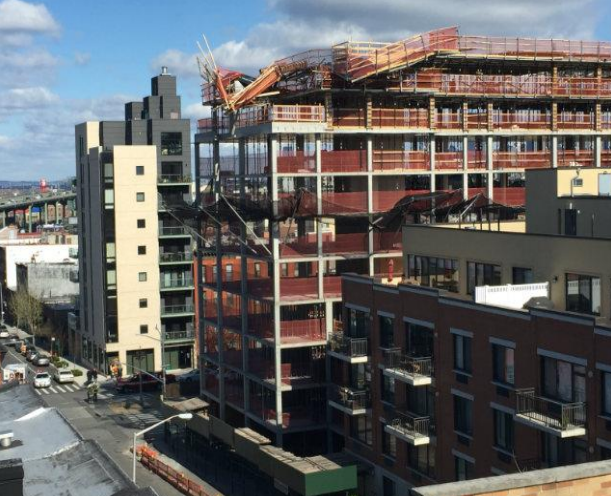
What do you think caused the partial collapse of the top floor at this construction site’

Many of the safety hazards in a workplace are created by the types of materials, equipment, substances and operations being used or performed in that workplace. And to a large extent, you can control those hazards because you control the workplace.
But safety hazards can also be created by conditions beyond your control, such as the weather. For example, high winds can blow around tools and materials, and cause equipment, such as cranes, and structures to collapse.
For example, this picture shows the partial collapse of the top floor of a building under construction in Brooklyn, NY. At the time, the National Weather Service had issued a high winds warning in the NYC area due to 40+ MPH winds.
Fortunately, no one was injured. But other wind-related safety incidents have resulted in injuries and fatalities:
- A family was walking down a street in Alberta when wind blew a bundle of steel off the roof of a construction project, striking them. The three-year-old daughter died; the husband and son were injured.
- A young worker in New York was part of a crew installing metal decking on the roof of a car dealership. As he tried to secure sheets of decking, he was blown off the roof by a wind gust and fell 24 feet to his death.
- A student at Notre Dame filming a football practice from a scissor lift was killed after strong winds toppled the lift.
- High winds knocked over a tractor-trailer, which ended up on its side in a ditch. The driver and a passenger were taken to the hospital with non-life-threatening injuries.
- As a crew installed additional bracing to rafters on a building under construction, wind conditions worsened and caused the rafters to collapse, trapping a worker and seriously injuring his right leg.
6 WIND SAFETY TIPS
Follow these safety tips if high winds or wind gusts could endanger workers or others:
- Pay attention to forecasts, especially wind speeds, and plan work activities accordingly.
- Don’t permit workers to work on scaffolding, elevated lifts, cranes, etc. in high winds. Also, ensure such equipment is secured properly so that it doesn’t blow over or collapse.
- Take steps to tie down or otherwise secure materials and tools to prevent them from blowing around or away. Particular attention should be paid to lighter materials such as sheets of insulation or vinyl and metal siding, which can easily become airborne.
- Inspect solid fencing, concrete formwork and false work, and vertical walls on incomplete buildings to ensure they can withstand high winds. Install additional supports if necessary.
- Inspect the worksite after the wind has died down to check the structural integrity of buildings, scaffolds, falsework and formwork, and ensure that any hazards created by the high winds are addressed before work resumes.
- Ensure workers wear appropriate PPE in windy conditions, including eye protection and safety headgear.
